中职英语基础模块教案4
中职英语基础模块上册 教案Unit4
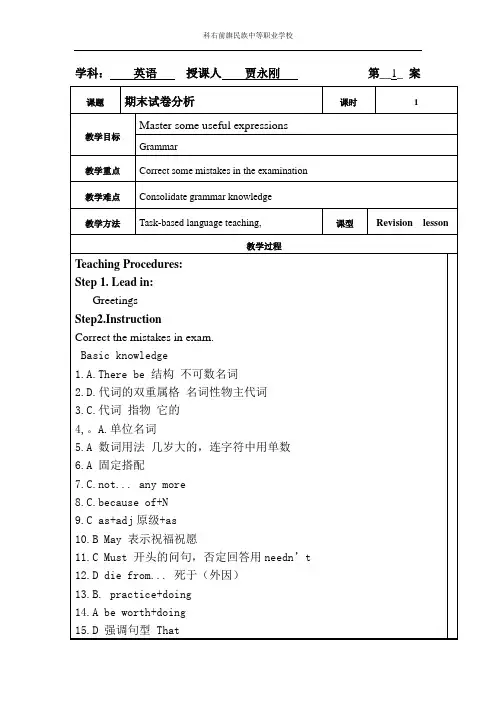
10.be +时间长度+late
Step4Practice
Do the exercise on textbook
Step5.Summary
Some useful expressions
Step5. Homework
1.Revise the text and some expressions.
3)表编号.结构:名词(首字母要大写) +基数词= the +序数词+名词
Lesson One = the first lesson注:有些编号,一般仅用第一种表达法。Room 101
Step3.Practice
Do the exercise on workbook
Step4.Summary
Some useful expressions about“Numerals
2)对事物的编号用基数词,门牌号,房间号,页码,电话号码等通常用基数词。Turn to page twenty-one. He lives in Room 801.
3)表示百分数用基数词。Thirty percent of term is water.
4)表示分数时,分子为基数词分母为序数词,若分子大于1,分母上的序数词要用复数。one third two fifths
课时
1
教学目标
To help the Ss master the reading skills of skimming and scanning
To help the Ss learn to cooperate
情感目标
To help the Ss be aware ofimportance of time
最新中职英语基础模块(语文版上册)授课教案:unit4Time英语
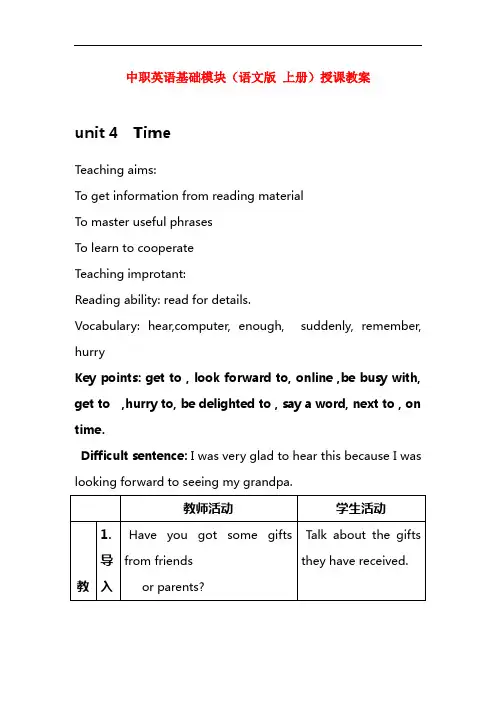
3)worktogether.
After that, ask students to read and write out the key points by themselves.
Teacher will check and give some example .
Step1 Lead in
Showsomepictures about foodandgive a question,
Ask the students to discuss
Let students listen to the questions carefully and talk freely, and then give the answers
in China.
7.Some parents sometimes go to KFC or McDonald’s to eat
with their children.
Finish the questions
Check the students’
reading
comprehension
Step 6 Topic discussion
中职英语基础模块(语文版上册)授课教案
unit 4 Time
Teaching aims:
To get information from reading material
To master useful phrases
To learn to cooperate
Teaching improtant:
Reading ability: read for details.
检测
中职英语基础模块一Unit4完整教案
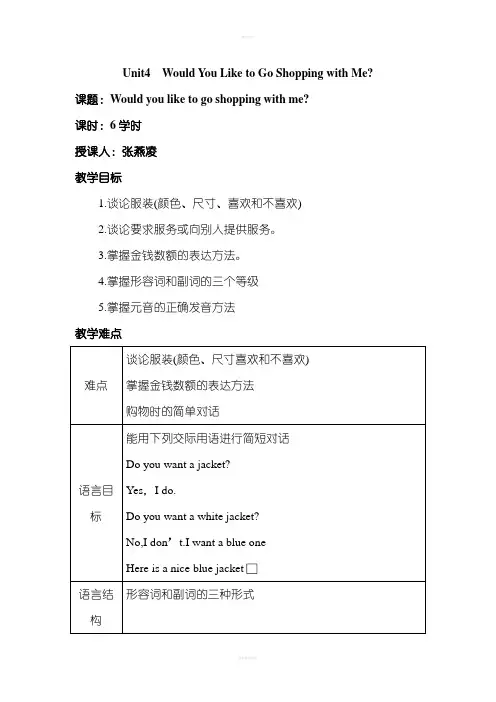
Unit4 Would You Like to Go Shopping with Me? 课题:Would you like to go shopping with me?课时:6学时授课人:张燕凌教学目标1.谈论服装(颜色、尺寸、喜欢和不喜欢)2.谈论要求服务或向别人提供服务。
3.掌握金钱数额的表达方法。
4.掌握形容词和副词的三个等级5.掌握元音的正确发音方法教学难点Here is a nice blue jacket教学重点:学会简单的购物交际用语教学方法:讲解法、提问法、分析法、角色扮演法教学过程:角色扮演(ROLE PLAY)1.教师可根据初中学过的知识丰富谈话的内容,例如A: May I help you?B: Yes, please. These shoes are too smallA: Oh,I’m sorry. Do you have the receipt?B: No,I’m sorry. It’s at homeA: I need a shirt, pleaseB: Ok.What size?A: Small. And do you have this jacket in medium?B: Yes, I think so2.明确口语活动的任务,要求学生仔细阅读图片。
必要时可做简单的对话示范。
3.学生成对活动,轮流作SpeakerA和SpeakerB。
4.教师巡视全班,聆听学生对话,并解答学生提出的问题。
5.挑出几个学生在班上表演。
6.此外还可以通过做游戏来训练学习的口语表达能力,例如;让学生以小组为单位或全班一起做一次连锁游戏,在这个游戏中每一个学生必须在I’m looking for 这个句子后添加内容,例如:教师说:“I’m looking for a green shirt”这个穿绿体恤的学生就来说“I’m looking for…”以此类推。
或者是教师在黑板上图表中的NAME下画一个问号,描述班级内一个同学的服装。
最新中职英语基础模块Unit4教案设计
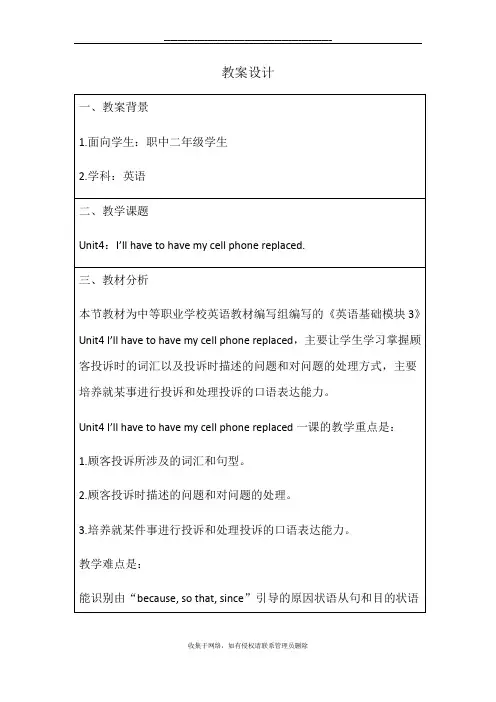
教案设计中秋节主题班会教案设计一、活动目的:1、中秋节是中国的传统节日,通过中秋节让学生初步理解中国传统节日中所蕴涵的文化内核,真正了解节日,了解中国传统文化,帮助青少年增强科学节日文化理念,弘扬创新节日文化。
2、介绍中秋节的来历,了解中国各地过中秋的风俗。
3、增强学生爱父母爱家乡爱祖国的感情,让节日真正给我们带来快乐与幸福。
二、活动时间:xxxx年9月17三、活动准备:苏轼的《水调歌头》ok带、中秋灯谜、图画、月饼四、活动地点:六(1)班教室五、活动过程:老师导入:中秋节,是中国的传统节日。
从去年开始,国家把这个节日定为法定节日,休息一天。
从而可以看出,中国逐渐对传统文化和民俗越来越重视。
今天我们一起来走进中秋佳节,一起来感受中秋佳节。
一、中秋节的来历和风俗1、中秋节的由来(1)老师:队员们?每当天气晴朗的夜晚,天空上有什么?月亮像什么?(有月亮。
月亮像玉盘、像圆饼。
)(2)、出示圆形月饼,让学生比较。
老师:月亮在最圆的时候是什么日子?(每个月的十五日左右。
)(3)、说中秋节的由来。
老师:谁知道中秋节的来历?(4)、小结:队员们都说得很好,八月十五中秋节的时候月亮圆满,象征团圆,所以也叫团圆节。
它起源于魏晋时期,在唐朝初年成为我们国家固定的节日,这也是我国仅次于春节的第二传统节日。
中秋的另一个说法是:农历八月十五这一天刚好是稻子成熟的时刻,每家都拜土地神,中秋可能是秋报的遗俗。
2、中秋节的传说与民间故事(1)老师引:中秋节在我们中国人眼里,可是非常重要的佳节。
“月圆人团圆”,那是一个温馨和谐、及富诗情画意的节日。
中秋节最有名的传说故事就是嫦娥奔月了老师:有谁能来讲讲有关中秋节的传说,中秋节的起源及一些民间故事?生:嫦娥奔月(后羿射日):(2)指名讲述嫦娥奔月的故事。
(3)引导队员讲述不同版本的传说,吴刚伐桂;玉兔捣药等等。
老师(小结):看来中秋节是最有人情味、最诗情画意的一个节日。
3、队员介绍中秋节的习俗老师引:好,听了我给你们讲的故事,你们一定意犹未尽吧。
Unit 4 Time 教案 中职英语基础模块上
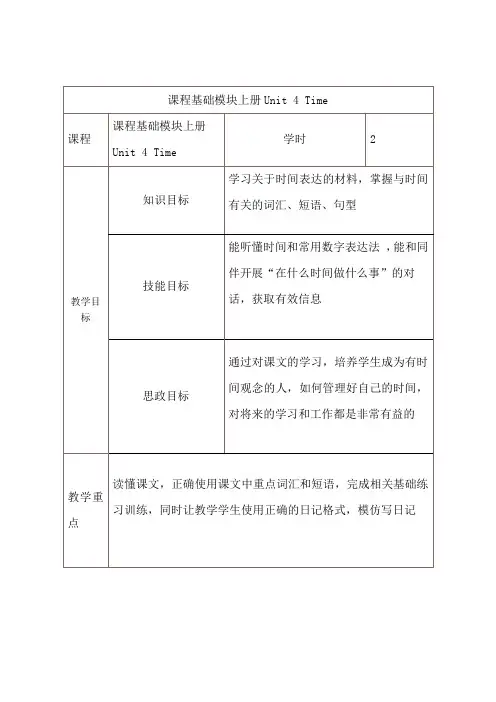
(1) look forward to期望,期盼
(2) get up…起床
(3) online上网
(4) in great joy兴高采烈地
(5) hurry to急忙
(6) talk with与……谈话
(7) be busy with忙于
(8) no matter what无论什么
(9) on time按时,准时
(4) How did his grandpa come his home from the airport?
(5) What gift did his grandpa give to him?
5.精读课文后,让学生回答上面5个问题。
6.各组派一位代表总结课文中 4 个自然段主 要意思:
Para1: I will get to the airport before 9:30 to meet my grandpa.
(3)中国制造2025,读作Made in Chinatwenty twenty-five
(4)What date is today?
Today is the second day of May.
3.时间表达法
(1)What time it is ? It is...
(2)It’s time to do ...
教学手段
多媒体、录音机、图片等
教学过程
教学内容
教学设计
热身活动1.先让学生复习,说出基数词序数词 1-20的读法。
2.再让学生说出生活中常见数字读法,如:手
机号、车牌号、门牌号、年份、日期等。
(1)403室,读作room four o (或zero) three
(2)1968年,读作nineteen sixty-eight
最新中职英语基础模块教案:Unit4Whattimeisit(第一课时)
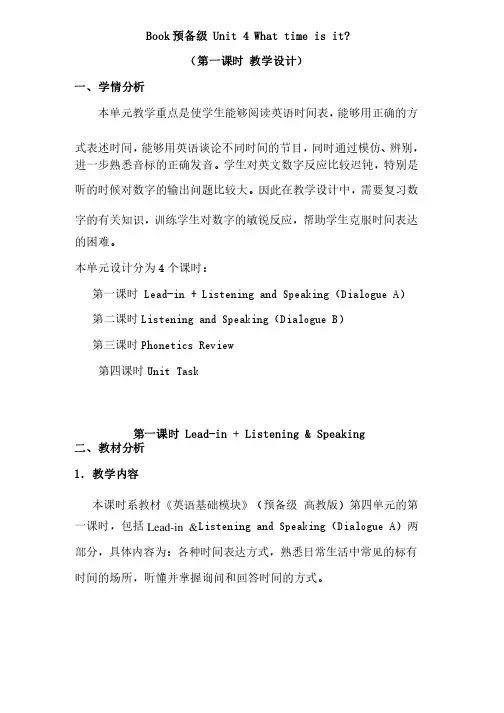
Book 预备级 Unit 4 What time is it?(第一课时教学设计)一、学情分析本单元教学重点是使学生能够阅读英语时间表,能够用正确的方式表述时间,能够用英语谈论不同时间的节目,同时通过模仿、辨别,进一步熟悉音标的正确发音。
进一步熟悉音标的正确发音。
学生对英文数字反应比较迟钝,学生对英文数字反应比较迟钝,学生对英文数字反应比较迟钝,特别是特别是听的时候对数字的输出问题比较大。
听的时候对数字的输出问题比较大。
因此在教学设计中,因此在教学设计中,因此在教学设计中,需要复习数需要复习数字的有关知识,训练学生对数字的敏锐反应,训练学生对数字的敏锐反应,帮助学生克服时间表达帮助学生克服时间表达的困难。
本单元设计分为4个课时:第一课时第一课时 Lead-in + Listening and Speaking Lead-in + Listening and Speaking Lead-in + Listening and Speaking((Dialogue A Dialogue A))第二课时Listening and Speaking Listening and Speaking((Dialogue B Dialogue B))第三课时Phonetics Review第四课时Unit Task第一课时 Lead-in + Listening & Speaking 二、教材分析1.教学内容本课时系教材《英语基础模块》本课时系教材《英语基础模块》(预备级(预备级高教版)第四单元的第一课时,包括Lead-in & L istening and Speaking Listening and Speaking Listening and Speaking((Dialogue A Dialogue A)两)两部分,具体内容为:各种时间表达方式,熟悉日常生活中常见的标有时间的场所,听懂并掌握询问和回答时间的方式。
最新中职英语基础模块教案:Unit4Whattimeisit(第二课时)
Book 预备级 Unit 4 What time is it?(第二课时教学设计)一、教材分析1.教学内容本课时系教材《英语基础模块》(预备级高教版)第四单元的第二课时,包括Listening and Speaking(Dialogue B)部分,具体内容为:通过听力辨别时间,了解时差的基本知识,掌握询问时间的方法和各种表达方式,能根据时刻表进行对话。
2.教学重点、难点⑴教学重点能够听辨时间,了解时差的基本知识,掌握询问时间的方法和各种表达方式。
⑵教学难点能根据时刻表进行对话二、教学目标1.知识目标⑴掌握基本词汇,如travel, plan, flight, schedule, Moscow, Tokyo, New York, London;⑵通过听力辨别时间并能根据日常生活中涉及时间的票据进行提问和回答;(3)am 和pm的基本用法;2.能力目标(1)初步了解时差的基本知识并就不同城市的时间进行对话练习;(2)学生能掌握询问时间的方法和各种表达方式,并根据真实的生活场景进行对话;3.情感目标(1)学生掌握中国人与英美国家的人们在时间观念上的不同;(2)学生了解在不同场合下的时间表达方式;三、教学步骤Step One Lead-in (10m)1.The teacher greets each student: Good morning. Nice to meetyou. Ask them some questions:Would you please tell what time it is now?What time can we have a break?What time do you usually have lunch?What time do you usually go home?……(设计意图:复习第一课时教学内容,让学生学会用英语表达学校作息时间悉。
)2. Show the students a clock and invite some students to set certain time on the clock. Ask other students to speak out the time.(设计意图: 将学习内容真实化,也可以激发学生的学习兴趣。
中职职业英语 基础英语模块第四单元教案
See you later. = Informal way to say“Good-bye”
B. Circle the correct answers. Then compare your answers with a classmate.
D. Listen. Circle the two activities you hear.
Tell students they are going to listen to twoconversations in which people talk about
different activities. Tell students they need to listen for the activities listed here that the
Ask “Can Andy rollerblade?” “Can Susan/Nathan/Karen rollerblade?”
Explain that“Let’s”means “Let us,”and that it is another way of making a suggestion.
Have students make suggestions with “Let’s.”
Tell students to put a single check next to eachactivity with one person and two checks
next to activities with more than one person.
C. PAIR WORK Discuss. Do you enjoy these activities?
外研社中职英语基础模块第一册unit4教案
英语课程教案课题School Becomes Interesting教学时数 4 授课教师田微授课班级13电厂、热动、测量、水工班教材《英语》(基础模块)第一册,外研社教学目标一、语言知识目标1.掌握与一般现在时连用的频度副词的用法。
2.掌握一般现在时的否定句和一般疑问句的变换方法。
二、语言技能目标1.能够听懂介绍日常学习和生活的用语。
2.能根据本单元的课文及对话,针对所提供的信息谈论自己的学校生活。
3. 能够根据所给信息进行词组造句等书面表达。
4. 学习介绍自己的学习和生活。
三、情感与策略通过学习本单元,熟悉职业学校的校园生活,养成良好的学习习惯。
教学重点能够听懂介绍日常学习和生活的用语教学难点能够用英文谈论自己的学校生活教学准备投影仪,笔记本,PPT课件教法学法讲述法:通过教师给学生讲述重点难点,帮助学生掌握课文。
演示法:通过使用PPT课件,使学生在生动的环境下学习重点知识点,提高他们学习的兴趣。
总体思路本单元以介绍中职学生的日常学习、生活为主,通过学习这部分内容,让学生更加了解中职学校的特点。
重点教学环节设计个性化教学一、复习:通过上一单元的学习,我们学习了如何谈天气。
在这里复习下重点知识。
①write the words in English.多云的暴风雨刮风的晴朗的在北方②reading:.Read the text of reading and writing二、新课导入童鞋们来到职业学校学习,学习和生活上都会与以前不同,那么这里的生活是什么样子的呢?Warming up首先用PPT给出书上的图片及单词,然后让学生进行连线。
Then let’s study the words. 教学光盘及下载的网络知识可以活跃课堂气氛,亦可以增加学习效果。
First, answer the questions: Then study the words ③Do exerciseListening and SpeakingTo learn the new words.then listen to the dialogue and repeat.首先,让学生先自己听录音,然后将难点在书上标记,这样便于听讲,之后,根据录音跟读对话。
中职英语基础模块上unit4 time教案
Unit4 TimeReading:A Gift from GrandpaTeaching aims:[知识与技能]1.训练学生的阅读技巧。
2.提高学生的阅读能力。
[情感态度与价值观]1.培养学生学习英语的兴趣;2.通过对课文的学习,教育学生做一个有时间观念的人。
Teaching important and difficult points:1.了解文章大意并能复述。
2.对一些词汇用法的掌握:get to , look forward to, online ,be busy with, get to ,hurry to, be glad to , too...to, next to , on time.Teaching methods:1.多媒体辅助教学。
2.任务型语言教学。
3.以学生为中心的教学。
Class(课时):1课时Teaching procedures:Step1:Lead-inIt has no feet(脚), but it can walk(走) with its hands (手). It has no mouth(嘴巴), but it can speak to you. It calls Tick, Tick, and Tick every day.一个猜物游戏引出本课单元标题—Time.Step2: warming up复习初中知识:如何询问时间及相应的回答What time is it?/What’s the time?It is...Review the expression of the time (复习时刻的表示方法)Step3:SkimmingRead the text quickly,and find out the main idea.找出本文的主题句。
(抢答)No matter what to do, just do it on time.Step4:ScanningParagraph 1:How did the boy feel when he heard his grandpa would come? Why?给出问题,要求同学朗读本段,之后完成。
- 1、下载文档前请自行甄别文档内容的完整性,平台不提供额外的编辑、内容补充、找答案等附加服务。
- 2、"仅部分预览"的文档,不可在线预览部分如存在完整性等问题,可反馈申请退款(可完整预览的文档不适用该条件!)。
- 3、如文档侵犯您的权益,请联系客服反馈,我们会尽快为您处理(人工客服工作时间:9:00-18:30)。
Unit 4 favorite food (The 3rd period--reading) 教学目标:
1、掌握重要单词
because hear problem answer enough leave computer game suddenly remember hurry hour late find talk busy angry table ticket minute news homework
2、重要短语的识记与运用
get to in the morning look forward to get up in great joy hurry to talk with be busy with be delighted to say a word next to on time
教学重点:
学习并掌握文章中的重要短语及句型
教学难点:
文中精彩句子的熟练运用
教学方法:
讨论法、练习法
教学过程:
一、复习检查(听写、小组互查)
本单元重要单词。
because hear problem answer enough leave computer game suddenly remember hurry hour late find talk busy angry table ticket minute news homework
重要短语的识记与运用
get to in the morning look forward to get up in great joy hurry to talk with be busy with be delighted to say a word next to on time leave for
二、出示目标,自主学习
互相讨论,找出文章中重要短语、句型
1、重要短语
get to in the morning look forward to get up in great joy hurry to talk with be busy with be delighted to say a word next to on time leave for
2、重要句型
I was very glad to hear this because I was looking forward to seeing my grandpa .
I had enough time to do something before leaving for the airport.
It was lunch time when I got home.
④I was too ashamed to say a word.
⑤Here is a small gift for you.
⑥It can tell you what the time is.
⑦No matter what to do ,just do it on time .
⑧Time is money.
3、知识点导学
1、 look forward to (期望... ..) be used to (习惯于.....) stick to(坚持.....) pay attention to (注意.....) object to (反对...)
2、 have time to do 有时间做.....
I t is time for ...
It is time to do... 该是做......的时间了。
3、 be busy with sth =be busy doing sth 忙于做某事
4、 too… to "太……而不能……"
5、 Leave for... “动身前往……”
6、 No matter what...“无论什么”,作让步状语
7、 In the moring 在早上具体的某天早上用"on"
eg.On a rainy morning “下雨的早上”
四、课内检测
翻译:
1、我期盼你的来信。
2、他昨天动身去上海了。
3、读课文时,请注意这些重点句型。
4、他现在正忙着做家务呢。
5、该是我们上课的时间了。
6、这个箱子太重了搬不动。
7、当我们听到这个消息时,每一个人都兴致勃勃的谈论着。
五、课后反思
选择题:CBADD。
